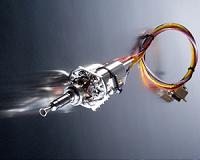 |
Canberra, Australia (SPX) Mar 24, 2010 Greg Combet, Minister for Defence Personnel, Materiel and Science, has announced that the Defence Science and Technology Organisation (DSTO) and the US Air Force Research Laboratory (AFRL) have successfully completed a second hypersonic flight at the Woomera Test Range. Hypersonic flight is flight through the atmosphere at speeds above Mach 5.5, or more than five times the speed of sound. "The flight represents a significant scientific milestone, enabling scientists to collect fundamental data critical to the design and development of an engine capable of sustained hypersonic flight," Mr Combet said. "The flight was the second in a series of up to ten planned flight experiments under a joint research program between DSTO and the US Air Force. "The program, called the Hypersonic International Flight Research Experimentation (HIFiRE), is investigating the fundamental science of hypersonics technology and its potential for next generation aeronautical systems. "The research being undertaken by DSTO and AFRL scientists is aimed at investigating fundamental air vehicle and propulsion technologies critical to the realisation of sustained hypersonic flight. "Hypersonic flight has the potential to revolutionise global air travel and provide cost-effective access to space, giving Australia the opportunity to launch satellites economically for communication purposes. "The continued collaboration between DSTO and the US Air Force Research Laboratory will help expedite the development of hypersonics technology and the potential for high-speed flights in the future. "Thanks to the work of this dedicated team of DSTO scientists, Australia is at the forefront of this technology," said Mr. Combet.
Share This Article With Planet Earth
Related Links MoD Australia Rocket Science News at Space-Travel.Com
 Green Satellite Fuel Designed To Make Space Safer
Green Satellite Fuel Designed To Make Space SaferParis, France (ESA) Mar 17, 2010 On the day running up to launch when a spacecraft is fuelled, ground personnel look more like astronauts than engineers, putting on spacesuit-like protective gear. This is an essential precaution when dealing with the current hydrazine fuel, but a new development could make satellite fuelling no more dangerous than filling up a car. First used in rocket engines by the German Luftwaff ... read more |
|
| The content herein, unless otherwise known to be public domain, are Copyright 1995-2010 - SpaceDaily. AFP and UPI Wire Stories are copyright Agence France-Presse and United Press International. ESA Portal Reports are copyright European Space Agency. All NASA sourced material is public domain. Additional copyrights may apply in whole or part to other bona fide parties. Advertising does not imply endorsement,agreement or approval of any opinions, statements or information provided by SpaceDaily on any Web page published or hosted by SpaceDaily. Privacy Statement |